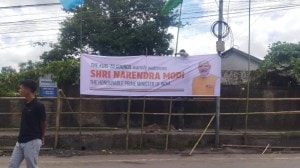Nicobar village leaves behind a graveyard, from past & present
If and when anyone from the local administration or any relief agency travels 6 km from the deluge-struck IAF base here, as The Indian Expre...

If and when anyone from the local administration or any relief agency travels 6 km from the deluge-struck IAF base here, as The Indian Express did today, they will see a ghost village where 1,000 people once lived. And they will see a graveyard—of the past and the present.
As you enter Malacca village via a dirt-track that leads off from a metalled road—remarkably untouched—the first thing that catches the eye is a cluster of white headstones with crosses.
About 15 of them, their inscriptions are covered with sand: Balentine, daughter of Edgar, Death on 18.6.99; Annie, W/o (wife of) Zacharia, died on 10.6.90; Dorothy D/o (daughter of) Anthony, died on 19.5.73.
Whether one day there will be a headstone inscribed with Died on 26.12.04 is anybody’s guess. Because today, there is no one here.
The church, next to this cemetery, has been destroyed leaving behind brick columns and corrugated iron sheets. The only two surviving structures are the village temple, ‘‘Murugan Temple’’ painted on its entrance, inside a Shiva idol, intact. And the deserted two-storeyed brick building, the Malacca High School.
In the over two hours that this correspondent spent in the village, six dogs were the only sign of life. There is noise except for these dogs scurrying around and the waves in the sea. And although it’s invisible, death is everywhere, its overpowering stench rising from countless piles of rubble strewn across several square miles.
The bodies cannot be seen but the stench leads you to them, trapped in the rubble. From the debris, you can make out that this was a relatively prosperous village. Piles of rubble marking places where houses once stood are eerily identical: bicycle, two-wheelers, tape recorders, cooking utensils, plastic shelves, fridges, TV sets, medicine cabinets, steel almirahs.
Those who survived have fled, these objects hold no attraction. One of them, at the IAF air base hangar which is serving as a shelter, is Rhoda who sits with her six-year-old daughter. Her sister Tora lost her daughter Magdalene. They walked to the base and now want to get out, out of what was once their home, to Port Blair.
Deputy Commissioner of Car Nicobar G C Joshi will not answer any questions about rescue and relief measures. Perhaps the task is daunting, for the stress is palpable—he even threatens to arrest this correspondent for not taking ‘‘official permission’’ before going to the village.
In fact, the exodus from Car Nicobar has begun as residents, their villages flattened, wait to be airlifted to Port Blair. ‘‘Relief is not coming here, we hope we may get something there,’’ says Jamir Ishaq, a resident of Sawai village, about 25 km from the airbase, who is waiting to leave.
He is joined by others, not only from Malacca but similarly affected villages, Kimous, Arong, Perka, Tamool, Kinyka, Jayanti, Lapati and Kinmai.
Among those Malacca residents known to be dead are Suresh K Joshi, Chief Judicial Magistrate for Car Nicobar; malaria research officer M K Das has lost his wife and children.
Meanwhile, the damage at Indira Point is the latest that has come to light. No team has reached there except for one Coast Guard ship. One of Indira Point’s most distinguishable landmarks, the lighthouse, seems to be under water. For the tip is the only thing visible, said officials.
Another island where damage is being discovered is Katchal where only today, a platoon of the Indo Tibetan Border Police was sent. At least a dozen policemen on this island are feared dead.
Photos





- 01
- 02
- 03
- 04
- 05


























